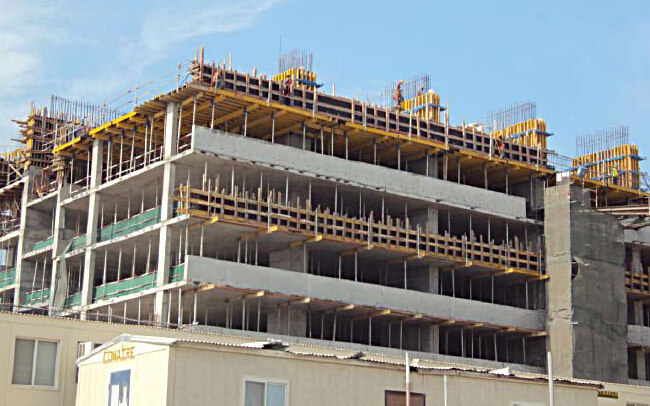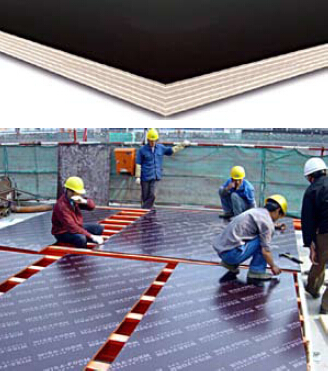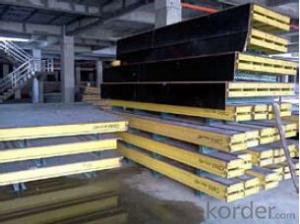Plywood Formwork Systems for Formwork and Scaffolding
- Loading Port:
- Tianjin
- Payment Terms:
- TT OR LC
- Min Order Qty:
- 50 m²
- Supply Capability:
- 1000 m²/month
OKorder Service Pledge
Quality Product, Order Online Tracking, Timely Delivery
OKorder Financial Service
Credit Rating, Credit Services, Credit Purchasing
You Might Also Like
Plywood --- make perfect concrete surface
WISA-Form Birch is a coated special plywood using in the formwork systems where high
requirements are set on the concrete surface and the times of reuses.
With CNBM timber beam & WISA plywood, the formwork is low weight but high load capacity, it is
widely used in construction.
Characteristics:
◆ Component with high standardization.
◆ Assembling in site, flexible application.
◆ Light weight, easy transportation and storage.


- Q:How are steel formwork panels connected together?
- To create a sturdy and stable structure for pouring concrete, steel formwork panels are joined together using various methods. One commonly employed technique involves the use of steel pins or bolts, which are inserted into pre-drilled holes in the panels. These pins or bolts are then tightened or secured with nuts, ensuring a firm connection between the panels. Another approach involves the utilization of clamps or couplers, which are positioned along the edges of the panels and tightened to hold them in place. These clamps or couplers can be easily adjusted or removed, allowing for flexibility in the formwork system. Furthermore, certain steel formwork panels possess interlocking mechanisms like slots or hooks, which enable effortless alignment and connection. These interlocking features facilitate a seamless connection between the panels, resulting in a smooth and uninterrupted surface for pouring concrete. In conclusion, the connection of steel formwork panels is vital for preserving the integrity and stability of the formwork system during the concrete pouring process. The chosen method of connection depends on the specific design and requirements of the project, as well as the type of steel formwork being utilized.
- Q:What are the different surface finishes available for steel formwork?
- Steel formwork for construction projects offers a variety of surface finishes to meet specific requirements and preferences. 1. The smooth finish is the most commonly used and involves grinding or sanding to achieve a sleek appearance. It is perfect for precise and visually appealing projects. 2. Textured finishes are suitable for projects that require a stronger bond with concrete. Techniques like shot blasting or textured form liners can create a textured surface, providing enhanced grip and adhesion. 3. For applications where slip resistance is crucial, brushed finishes create a slightly rough surface using wire brushes or abrasive pads. This finish is ideal for ramps and walkways. 4. Etched finishes involve a chemical process that produces a matte or patterned appearance. It is often chosen for decorative purposes, allowing for unique designs or patterns on the formwork's surface. 5. Galvanized finishes involve applying a layer of zinc through a coating process. This provides excellent corrosion resistance, making it ideal for harsh environments like marine or industrial applications. 6. Powder-coated finishes are both durable and decorative. They involve applying a dry powder to the formwork and curing it with heat. This versatile finish comes in various colors and offers exceptional resistance to impact, chemicals, and UV radiation. When selecting the appropriate surface finish for steel formwork, it is essential to consider project-specific requirements like durability, aesthetics, and environmental conditions. Seeking guidance from structural engineers or formwork suppliers can help determine the most suitable finish for the intended application.
- Q:Are there any specific design considerations for steel formwork?
- Yes, there are several specific design considerations for steel formwork. Firstly, the design should take into account the load-bearing capacity of the steel formwork. Steel has high strength and rigidity, but it is important to ensure that the formwork is designed to withstand the loads imposed by the concrete during pouring and curing. Secondly, the design should consider the dimensional accuracy required for the concrete structure. Steel formwork should be designed to provide precise dimensions and smooth finishes to ensure the desired shape and appearance of the final concrete structure. Thirdly, the design should incorporate proper connection details for assembling and dismantling the steel formwork. It is important to ensure that the formwork can be easily assembled and disassembled, as this can significantly impact the construction timeline and efficiency. Additionally, the design should consider the ease of handling and transportation of the steel formwork. Steel formwork components should be designed to be lightweight and easily maneuverable, making it easier for construction workers to handle and transport them on site. Furthermore, the design should take into account the durability and longevity of the steel formwork. Steel is known for its high durability and resistance to corrosion, but proper protective coatings or treatments should be specified to ensure the longevity of the formwork and prevent any degradation over time. Lastly, the design should consider any specific requirements or constraints of the project, such as special architectural features, complex geometries, or unique structural elements. These considerations may require custom design solutions to meet the specific needs of the project. Overall, the design considerations for steel formwork involve load-bearing capacity, dimensional accuracy, connection details, ease of handling and transportation, durability, and any project-specific requirements.
- Q:How does steel formwork contribute to the overall cost of concrete construction?
- Steel formwork can significantly contribute to the overall cost of concrete construction due to its initial higher cost compared to other formwork materials such as wood or plastic. However, it offers various advantages such as durability, reusability, and the ability to withstand higher loads, resulting in reduced labor and material costs in the long run. Moreover, steel formwork provides better quality finishes, faster construction time, and improved safety on-site, which can lead to overall cost savings and enhanced project efficiency.
- Q:How does steel formwork affect the overall constructability of a structure?
- The overall constructability of a structure can be significantly impacted by steel formwork. One of the main benefits of using steel formwork is its durability and strength. Steel is renowned for its high load-bearing capacity, enabling it to withstand the pressure exerted by fresh concrete during pouring and curing. This durability guarantees that the formwork remains stable and intact, minimizing the risk of collapse or deformation during construction. Another advantage of steel formwork is its reusability. Unlike traditional formwork materials like timber, steel can be utilized multiple times without compromising its structural integrity. This not only saves costs associated with purchasing new formwork for every construction project but also reduces waste and promotes sustainability. Steel formwork also provides flexibility and versatility in terms of design and construction requirements. It can be easily fabricated into various shapes and sizes, enabling the construction of intricate structures with detailed architectural elements. Steel formwork can be customized to suit specific project needs, facilitating efficient and precise construction. Furthermore, steel formwork delivers a smooth and uniform finish to the concrete surface. This eliminates the need for additional finishing work, such as plastering or sanding, thereby reducing construction time and costs. The smooth finish also enhances the aesthetic appeal of the structure, making it suitable for architectural projects where visual appeal is crucial. Moreover, steel formwork is recognized for its excellent dimensional stability. It resists warping, shrinking, or expanding due to moisture or temperature changes, ensuring accurate and consistent dimensions throughout the construction process. This dimensional stability contributes to the overall quality and precision of the structure. In conclusion, steel formwork has a positive impact on the overall constructability of a structure by offering durability, reusability, flexibility, a smooth finish, and dimensional stability. These advantages not only enhance construction efficiency and speed but also guarantee the structural integrity and aesthetic appeal of the final product.
- Q:Can steel formwork be used for curved or irregular-shaped structures?
- Indeed, curved or irregular-shaped structures can be constructed using steel formwork. Unlike conventional timber formwork, steel formwork boasts enhanced flexibility and strength, rendering it ideal for intricate shapes and designs. With steel formwork, it is effortless to bend or fabricate it into any desired shape, facilitating the construction of curved walls, columns, and slabs. Furthermore, steel formwork delivers exceptional support and stability, guaranteeing the precision and accuracy of the eventual structure. Its durability and reusability further contribute to its cost-effectiveness in projects involving curved or irregular-shaped structures.
- Q:How is steel formwork assembled?
- Steel formwork, also known as steel shuttering, is a popular choice for construction projects due to its durability and reusability. The assembly process of steel formwork involves a series of steps to ensure a secure and stable structure. Firstly, the steel formwork panels are laid out on the construction site in the desired configuration. These panels are typically made of high-quality steel and come in various sizes and shapes to accommodate different project requirements. Next, the panels are interconnected using different types of fastening systems, such as clamps, bolts, or pins. This ensures that the formwork remains rigid and stable during concrete pouring and curing. The fastening system used may vary depending on the specific design and requirements of the project. Once the panels are securely connected, adjustable props or braces are installed to provide additional support and stability to the formwork. These props are usually made of steel and can be adjusted in height to accommodate different concrete pouring heights. After the formwork structure is assembled and properly supported, it is ready for concrete pouring. The formwork acts as a mold, containing the fresh concrete until it hardens and gains sufficient strength. The concrete is poured into the formwork using pumps or buckets, and then it is vibrated or compacted to eliminate air pockets and ensure proper adhesion. Once the concrete has cured and gained sufficient strength, the formwork is carefully dismantled. The dismantling process involves removing the props, unfastening the panels, and carefully disassembling the formwork structure. The dismantled steel formwork can then be cleaned, inspected, and reused for future construction projects, making it a cost-effective and sustainable choice. Overall, the assembly of steel formwork involves laying out and connecting the steel panels, installing adjustable props for support, pouring concrete, and finally dismantling the formwork structure. This process ensures a robust and stable formwork system that facilitates efficient and high-quality concrete construction.
- Q:Can steel formwork be used in underground structures?
- Yes, steel formwork can be used in underground structures. It is commonly used in construction projects where durability and strength are essential, making it suitable for underground structures that require robust and long-lasting formwork.
- Q:How does steel formwork contribute to the strength and stability of a concrete structure?
- Steel formwork is a critical component in the construction of concrete structures as it plays a crucial role in enhancing their strength and stability. One of the key ways in which steel formwork contributes to this is by providing a robust framework for the concrete to be poured into and cured. The steel formwork acts as a mold or a template that holds the liquid concrete in place until it solidifies. This ensures that the concrete takes the desired shape and form, resulting in a structurally sound and stable structure. Furthermore, steel formwork provides support and reinforcement to the concrete during the curing process. As the concrete hardens, it exerts pressure on the formwork. The high tensile strength of steel allows it to withstand and distribute these forces evenly, thereby preventing any distortion or collapse of the structure. This is particularly important in the case of large-scale or complex structures where the concrete needs to be supported over extended periods. In addition, steel formwork facilitates the proper alignment and leveling of the concrete during the construction process. The rigid nature of steel ensures that the formwork remains in place and maintains its shape, resulting in accurate dimensions and a uniform finish. This contributes to the overall strength and stability of the concrete structure by eliminating any irregularities or weaknesses that may arise from inaccuracies in the formwork. Moreover, steel formwork can be easily assembled and disassembled, allowing for efficient construction processes. This flexibility enables faster construction timelines, minimizing the exposure of the concrete to external elements and reducing the risk of structural damage. The ability to reuse steel formwork also makes it a cost-effective solution for multiple construction projects. Overall, the use of steel formwork significantly enhances the strength and stability of concrete structures by providing a sturdy framework, supporting the curing process, ensuring accurate alignment, and facilitating efficient construction practices. Its durability, strength, and versatility make it an essential component in the construction industry, contributing to the creation of safe and reliable concrete structures.
- Q:Can steel formwork be used for both small and large concrete pours?
- Yes, steel formwork can be used for both small and large concrete pours. Steel formwork is highly versatile and can be easily adjusted or modified to accommodate different sizes and shapes of concrete structures. It provides high strength and stability, making it suitable for large pours where heavy loads and pressures are involved. Additionally, steel formwork can be reused multiple times, making it a cost-effective option for both small and large construction projects.
1. Manufacturer Overview |
|
|---|---|
| Location | |
| Year Established | |
| Annual Output Value | |
| Main Markets | |
| Company Certifications | |
2. Manufacturer Certificates |
|
|---|---|
| a) Certification Name | |
| Range | |
| Reference | |
| Validity Period | |
3. Manufacturer Capability |
|
|---|---|
| a)Trade Capacity | |
| Nearest Port | |
| Export Percentage | |
| No.of Employees in Trade Department | |
| Language Spoken: | |
| b)Factory Information | |
| Factory Size: | |
| No. of Production Lines | |
| Contract Manufacturing | |
| Product Price Range | |
Send your message to us
Plywood Formwork Systems for Formwork and Scaffolding
- Loading Port:
- Tianjin
- Payment Terms:
- TT OR LC
- Min Order Qty:
- 50 m²
- Supply Capability:
- 1000 m²/month
OKorder Service Pledge
Quality Product, Order Online Tracking, Timely Delivery
OKorder Financial Service
Credit Rating, Credit Services, Credit Purchasing
Similar products
New products
Hot products
Hot Searches
Related keywords
























